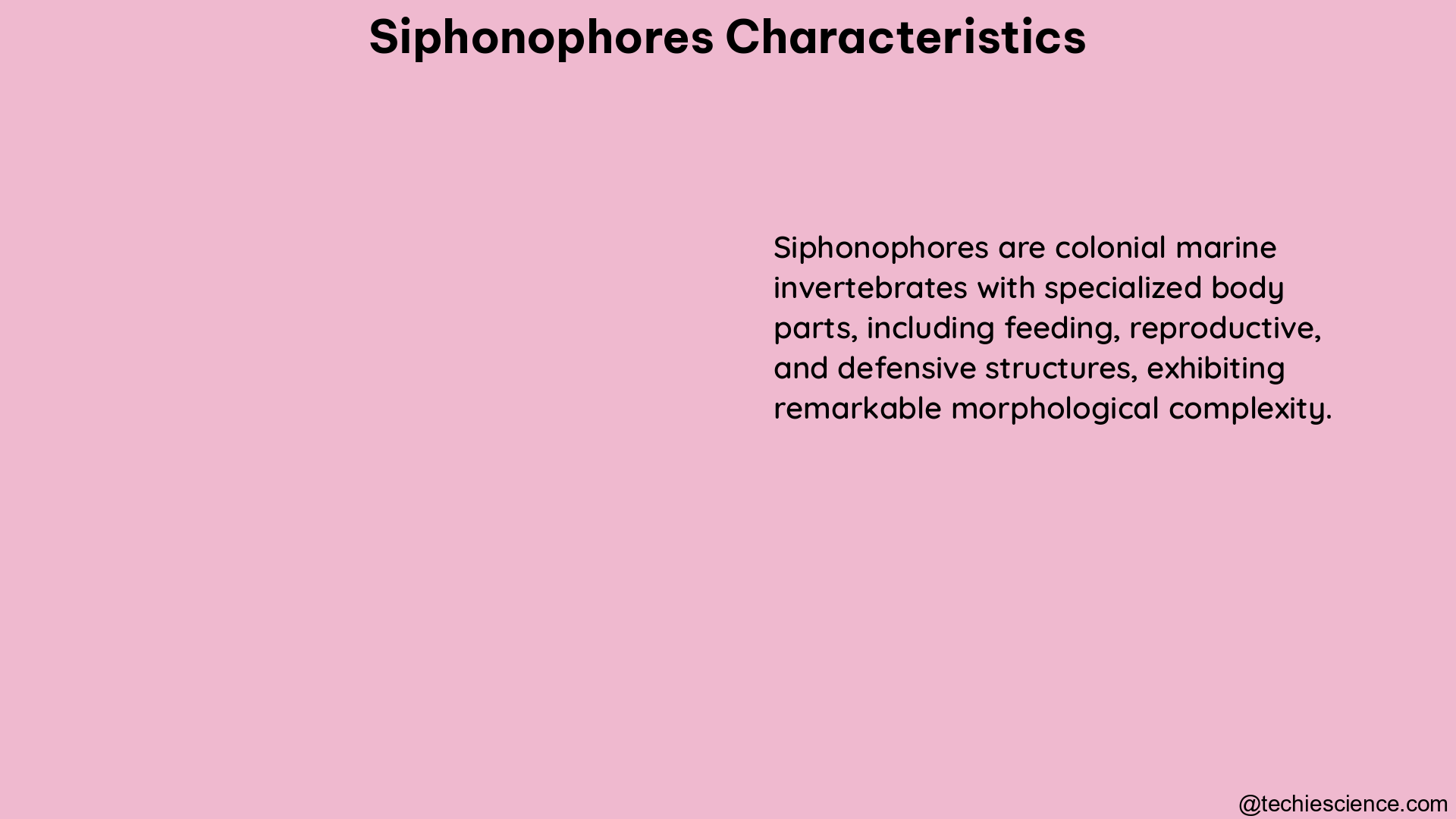Siphonophores are remarkable colonial organisms that have captivated the attention of marine biologists and enthusiasts alike. These free-living predatory hydrozoan cnidarians are found in every region of the ocean, from the surface to the depths of the twilight zone. Their unique characteristics make them truly one-of-a-kind creatures in the vast underwater world. In this comprehensive guide, we will delve into the intricate details of siphonophores, exploring their size, species diversity, tentacular structures, bioluminescence, colonial organization, depth distribution, feeding habits, and interactions with other marine life.
Siphonophore Size: Colossal Proportions
Siphonophores are known for their impressive size, with some species reaching truly colossal proportions. The largest siphonophore ever recorded measured an astounding 15 meters (49 feet) in diameter and 47 meters (154 feet) in length, making it one of the longest animals on the planet. This record-breaking specimen, belonging to the species Praya dubia, was discovered in the waters off the coast of Western Australia.
While the majority of siphonophores are much smaller, ranging from a few centimeters to several meters in length, their sheer size is a testament to the remarkable evolutionary adaptations that have allowed these colonial organisms to thrive in the vast ocean environments.
Siphonophore Diversity: A Vast Array of Species

Siphonophores are a highly diverse group of marine organisms, with scientists having identified over 175 distinct species to date. These species exhibit a wide range of morphological characteristics, from the delicate, translucent forms of the Physonectae suborder to the more robust, bell-shaped Calycophorae.
Each species of siphonophore has evolved unique adaptations to suit their specific ecological niches, with variations in their tentacular structures, feeding strategies, and colonial organization. This diversity allows siphonophores to occupy a wide range of habitats, from the sunlit surface waters to the dimly lit depths of the ocean twilight zone.
Tentacular Structures: Deadly Weapons of Prey Capture
One of the most distinctive features of siphonophores is their intricate tentacular structures, known as tentilla. These specialized appendages are equipped with numerous stinging cells, called cnidocytes, which they use to capture and subdue their prey. The tentilla can range from a few centimeters to several meters in length, depending on the species, and are arranged in complex, species-specific patterns along the siphonophore’s stem.
The tentilla are capable of rapid, coordinated movements, allowing siphonophores to effectively ensnare a wide variety of prey, including small crustaceans, copepods, and even small fish. The potency of the siphonophore’s sting can vary, with some species possessing more potent venom than others, making them formidable predators in the marine ecosystem.
Bioluminescence: Captivating Light Displays
Many species of siphonophores are capable of bioluminescence, the ability to produce and emit light through a chemical reaction within their bodies. This remarkable trait allows siphonophores to create a dazzling array of light displays, ranging from glowing green and blue hues to the more vibrant red and orange tones.
The bioluminescence of siphonophores serves a variety of purposes, from attracting prey to deterring predators. Some species, such as the Erenna siphonophore, have even been observed using their bioluminescent displays to mimic the swimming patterns of their prey, luring them closer within reach of their deadly tentacles.
Colonial Organization: Specialized Individuals, Collective Survival
Siphonophores are colonial organisms, meaning they are composed of numerous individual zooids, or specialized individuals, that work together to ensure the survival and reproduction of the entire colony. These zooids are arranged in a specific, species-dependent pattern along the siphonophore’s stem, with each individual performing a specialized function, such as swimming, feeding, or reproduction.
The colonial organization of siphonophores is a remarkable example of evolutionary adaptation, as the division of labor among the zooids allows the colony to function as a single, cohesive unit. This level of coordination and specialization is a key factor in the success of siphonophores as predators and their ability to thrive in diverse ocean environments.
Depth Distribution: Mastering the Vertical Realm
Siphonophores are found at a wide range of depths throughout the ocean, from the near-coastal regions to the dimly lit depths of the ocean twilight zone and even the seafloor. This remarkable depth distribution is a testament to the adaptability and resilience of these colonial organisms.
Some species, such as the Physonectae, are more commonly found in the upper layers of the ocean, where they can take advantage of the abundant prey and sunlight. Other species, like the Calycophorae, are better adapted to the high-pressure, low-light conditions of the deep ocean, where they may encounter different prey and face unique challenges.
The ability of siphonophores to thrive in such a diverse range of ocean environments is a testament to their evolutionary success and the remarkable adaptations that have allowed them to colonize the vast underwater world.
Feeding Habits: Efficient Predators in the Ocean
Siphonophores are highly efficient predators, using their specialized tentacular structures to capture a wide variety of prey, including small crustaceans, copepods, and even small fish. The specific feeding strategies employed by siphonophores can vary depending on the species, with some relying more on passive ambush tactics, while others actively hunt and pursue their prey.
One particularly fascinating aspect of siphonophore feeding is their ability to mimic the swimming patterns of their prey, using their bioluminescent displays to lure unsuspecting organisms within reach of their deadly tentacles. This remarkable adaptation highlights the evolutionary ingenuity of these colonial organisms and their ability to thrive in the competitive marine ecosystem.
Interactions with Other Marine Life: Predators and Prey
Siphonophores play a crucial role in the marine food web, serving as both predators and prey within the complex web of life in the ocean. While siphonophores are formidable predators in their own right, they are also subject to predation by a variety of marine organisms, including certain species of fish, sea turtles, and even other siphonophores.
One particularly intriguing example of siphonophore-predator interactions is the relationship between the siphonophore and the Phronima, a small crustacean known as the “pram bug.” Phronima have been observed hollowing out the gelatinous bodies of siphonophores, using them as protective “houses” to carry their young.
This intricate web of predator-prey relationships highlights the important ecological role that siphonophores play in the marine ecosystem, serving as both a vital food source and a unique habitat for other organisms.
Conclusion
Siphonophores are truly remarkable creatures, with a wealth of captivating characteristics that make them stand out in the diverse world of marine life. From their colossal size and impressive species diversity to their intricate tentacular structures, bioluminescent displays, and complex colonial organization, siphonophores are a testament to the evolutionary ingenuity of life in the ocean.
As we continue to explore and study these enigmatic organisms, we can expect to uncover even more fascinating insights into their biology, behavior, and ecological significance. Whether you’re a marine biologist, a nature enthusiast, or simply someone captivated by the wonders of the underwater world, the study of siphonophores is sure to provide a wealth of knowledge and inspiration.
References:
– Two views of the siphonophore Physophora
– Siphonophore – Explore the Ocean Twilight Zone
– Siphonophores: A Review of Their Biology and Diversity
– Creature Report: Siphonophores
– Siphonophores: A Review of Their Biology and Diversity

Hello, I am Bhairavi Rathod, I have completed my Master’s in Biotechnology and qualified ICAR NET 2021 in Agricultural Biotechnology. My area of specialization is Integrated Biotechnology. I have the experience to teach and write very complex things in a simple way for learners.